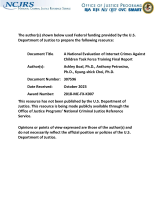Law enforcement technology
New Class of Antenna Array With a Reconfigurable Element Factor
RF MEMS Reconfigurable Two-Band Antenna
Tunable Zeroth-Order Resonance in Metamaterial Transmission Lines Based on Electrowetting on Dielectric
Frequency Reconfigurable Antenna based on Digital Microfluidics
Discouraging the Demand That Fosters Sex Trafficking: Collaboration through Augmented Intelligence
Effective Game-Based Training for Police Officer Decision-Making: Linking Missions, Skills, and Virtual Content
Broadband Communications Prioritization and Interoperability Guidance for Law Enforcement
Help-Seeking from websites and police in the aftermath of technology-facilitated victimization
A National Evaluation of Internet Crimes Against Children Task Force Training Final Report
Webinar: NIJ Research Assistantship Program Informational Webinar
This recorded webinar, originally held September 28, 2023, provides information on NIJ’s Research Assistantship Program, which offers highly qualified doctoral students the opportunity to bring their expertise to NIJ to work across offices and program areas to obtain a practical and applied research experience. The program is a research focused professional development opportunity for doctoral students from all academic disciplines. NIJ...
Support Activities under Section 13(d) of Executive Order 14074: Workshops on Law Enforcement Use of Probabilistic DNA Technologies and Person-based Predictive Policing
FIU - Forensic Technology Center of Excellence
Development of computational methods for genetic identification and kinship analysis of forensic samples
Can Science Enhance Equity? Findings and Implications From a Study To Detect Bruising on Victims with Dark Skin Pigmentation
This plenary panel from the 2023 NIJ Research Conference features fascinating research on a methodology to improve the detection and documentation of bruises on victims of violence who have dark skin pigmentation. This study highlights the intersection between science, justice, and racial equity, featuring practitioner and victims’ advocacy perspectives. The discussion describes the research and its findings and explore strategies to ensure that this particular evidence-based methodology can be widely implemented by nurse practitioners in the field.
Participants:
See the YouTube Terms of Service and Google Privacy Policy




